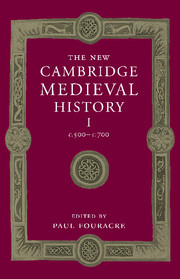Book contents
- Frontmatter
- Introduction: the history of Europe 500–700
- 1 The later Roman Empire
- 2 The Barbarian invasions
- 3 The sources and their interpretation
- PART I THE SIXTH CENTURY
- PART II THE SEVENTH CENTURY
- 11 The Byzantine empire in the seventh century
- 12 Muhammad and the rise of Islam
- 13 The Catholic Visigothic kingdom
- 14 Francia in the seventh century
- 15 Religion and society in Ireland
- 16 Christianity amongst the Britons, Dalriadan Irish and Picts
- 17 England in the seventh century
- 18 Scandinavia
- 19 The Slavs
- PART III THEMES AND PROBLEMS
- List of Primary sources
- Bibliography of secondary works arranged by chapter
- Index
- Frontispiece"
- Plate section"
- Map 3 Gaul/Francia in the sixth and seventh centuries"
- References
19 - The Slavs
from PART II - THE SEVENTH CENTURY
Published online by Cambridge University Press: 28 March 2008
- Frontmatter
- Introduction: the history of Europe 500–700
- 1 The later Roman Empire
- 2 The Barbarian invasions
- 3 The sources and their interpretation
- PART I THE SIXTH CENTURY
- PART II THE SEVENTH CENTURY
- 11 The Byzantine empire in the seventh century
- 12 Muhammad and the rise of Islam
- 13 The Catholic Visigothic kingdom
- 14 Francia in the seventh century
- 15 Religion and society in Ireland
- 16 Christianity amongst the Britons, Dalriadan Irish and Picts
- 17 England in the seventh century
- 18 Scandinavia
- 19 The Slavs
- PART III THEMES AND PROBLEMS
- List of Primary sources
- Bibliography of secondary works arranged by chapter
- Index
- Frontispiece"
- Plate section"
- Map 3 Gaul/Francia in the sixth and seventh centuries"
- References
Summary
In his Secret History, the Byzantine historian Procopius of Caesarea states that after Justinian (527–565) had come to the throne, the Huns and Slavs (Sclavenoi and Antes) had attacked Illyria and the whole of Thrace on an almost annual basis, hitting everything from the Ionian Gulf nearly to the gates of Byzantium itself. Greece and Chersones (in Thrace) were badly affected, and the invaders were oppressing the inhabitants of these territories. Who were these mysterious Slavic people who had arrived so suddenly on the scene, and created a threat to the Byzantine Empire, breaking through the Danubian frontiers, and in a relatively short time settling half of Europe from the lower reaches of the Elbe and the Baltic in the north, down as far as the Adriatic in the south? The earliest description of the Slavs comes from De Bellis, another work of Procopius, which was written just before the middle of the sixth century. He portrays them as unusually tall and strong, of dark skin and reddish hair, leading a rugged and primitive style of life and constantly covered in dirt, living in squalid huts which were isolated from one another, and often changing their place of abode. According to Procopius, the Slavs were not ruled by a single man, but for a long time they had lived in a democracy. They believed in one god, the creator of lightning, who was the only ruler of everything, and they made sacrifices to him of oxen and other animals. They went into battle on foot, straight at the enemy, and in their hands they had small shields and spears, but they did not wear armour.
Keywords
- Type
- Chapter
- Information
- The New Cambridge Medieval History , pp. 524 - 544Publisher: Cambridge University PressPrint publication year: 2005
References
- 6
- Cited by



